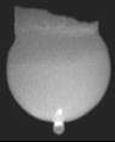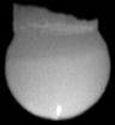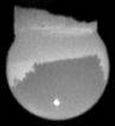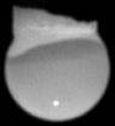
How is it made?


Splat cooling-a slight variation on this procedure-permits the formation of graphitic dendrites and delaminated membranes.
thermionic emission
tungsten filament
| e- |
graphite
iron
| current |
Molten metal dissolves carbon from graphite stem.
Origami graphite (pale phase) sweeps over melt surface, frequently with a polygonal boundary.
Displaced, distorted reflection of glowing tungsten filament provides evidence of faceted graphite surface.
As melt cools, graphite continues to precipitate. Resulting internal pressure can rupture the graphite shell.
Origami formation is reversible, by re-heating. Pale origami islands are stable, indicating solid film on dark area. See dendrites page for further evidence of non-origami curved graphite.
![]()




